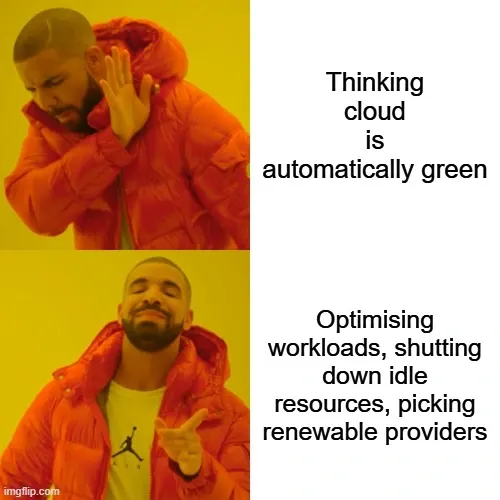Why Your Cloud Strategy Isn't as Green as You Think (+ Simple Fixes)

Your cloud optimisation efforts might not give you the environmental benefits you expect. The buzz around "Green Cloud" keeps growing, but cloud computing's CO2 footprint is a big deal as it means that the entire aviation industry's footprint. This environmental effect becomes even more striking since a single data center uses power equal to what 50,000 homes need.
Most organisations believe their cloud strategy helps the environment naturally. But you might miss great ways to cut emissions without the right cloud cost optimisation and a well-planned green cloud approach. Research shows that smart cloud optimisation strategies could reduce CO2 emissions by 59 million tons each year. That's like taking 22 million cars off the road.
The bright side? We can keep using cloud computing and protect our planet at the same time. A smart cloud optimisation strategy can revolutionise your digital infrastructure and support your sustainability goals. This piece will show you why your current approach might not work well enough and give you simple, practical ways to arrange your cloud services. These changes will help you meet both your environmental responsibilities and business goals.
Why your cloud strategy may not be as green as it seems
Cloud services offer huge benefits to businesses. Their virtual appearance masks a real environmental impact that many people misunderstand.
Hidden energy costs of cloud data centers
Data centers use massive amounts of electricity to power cloud services. These facilities now make up about 1-1.3% of global electricity demand[1]. Power usage will likely double from 460 terawatt-hours in 2022 to over 1,000 terawatt-hours by 2026. Data centers might use up to 20% of global electricity by 2025. A typical data center's electricity usage equals what 50,000 homes consume.
Cooling systems eat up over 40% of these facilities' total power consumption. North American data centers still largely depend on fossil fuel-based power grids. This dependence undermines efforts to make cloud services sustainable.
The myth of 'invisible' infrastructure
Moving to the cloud won't automatically reduce your carbon footprint - that's a dangerous myth. Cloud systems still need huge amounts of energy to run and maintain their infrastructure. On-premises systems can be greener than public cloud setups, depending on their power sources.
Cloud infrastructure's physical footprint creates environmental problems that customers rarely see. Raw materials for construction, billions of gallons of cooling water each year, and e-waste from hardware updates add up fast. Only 12.5% of this e-waste gets recycled.
Overlooked emissions from idle resources
Idle resources create a huge sustainability problem that often goes unnoticed. Companies waste about 32% of their cloud spending on idle or oversized resources. This waste leads to unnecessary energy use and emissions.
Idle power makes up 20-60% of maximum power usage. Servers waste between 100 watts to 1,300 watts when idle. Data centers use just 6-12% of their total energy for actual computing tasks.
Any good cloud optimisation strategy must tackle these hidden environmental costs to achieve true green cloud goals.
Key areas where cloud sustainability breaks down
Cloud services look sleek on the surface, but they hide four weak spots that can derail sustainability efforts. These problems affect your environmental footprint and work against real attempts to optimise cloud usage.
1. Poor data center location choices
The location of data centers affects their environmental performance by a lot. Data centers in cooler climates need less cooling, while those in warmer areas use much more energy to stay at the right temperature. Many cloud providers choose locations based on tax breaks or cheap land instead of thinking about the environment. This leads to many facilities ending up in places that need power-hungry cooling systems, which pump out more carbon emissions.
2. Lack of renewable energy sourcing
Digital tech now uses between 5-9% of global electricity[2]. This number will grow as digital tools and new technologies expand. Data centers in the EU alone saw their power needs jump from 54 to 77 terawatt-hours each year between 2010-2018. Most facilities still run on fossil fuel power instead of renewable sources. This dependence adds to greenhouse gas emissions and cancels out other green initiatives.
3. Over-provisioned and underutilized resources
Overprovisioning—giving out more resources than needed—creates huge waste. Resource usage in most data centers can be as low as 20%, and many organisations find their Kubernetes setup has 30% more than needed[3]. Research shows that companies waste 30-45% of their cloud spend. This waste means more energy use and environmental damage, plus wasted natural resources and extra emissions.
4. Inefficient cooling and hardware systems
Cooling systems eat up 40-50% of a data center's total power. Old-school computer room air conditioners waste energy but remain popular. Many facilities keep using outdated hardware that burns through power. Better options exist—cold plate cooling cuts emissions by 15% and uses 30-50% less water over a data center's life. Companies adopt these solutions slowly because of high upfront costs or because they don't want to replace working systems.
Simple fixes to make your cloud greener
Making your cloud practices more environmentally friendly doesn't require a complete infrastructure overhaul. Here are some straightforward improvements that can help reduce your cloud's carbon footprint:
1. Choose providers with renewable energy commitments
Major cloud providers have made great progress with renewable energy. Amazon reached its target of matching 100% of electricity consumed with renewable energy in 2023, seven years ahead of schedule. Google has managed to keep 100% renewable energy matching since 2017[4]. Your best bet is to pick providers who share clear sustainability reports and renewable energy plans.
2. Use auto-scaling and right-sizing for workloads
Right-sizing serves as the foundation of cloud optimisation by matching instance types to workload needs at the lowest cost. The system allocates resources based on actual needs through auto-scaling. These methods can reduce costs by up to 65% when resources are turned off during nights and weekends[5].
3. Implement cloud cost optimisation tools
Built-in tools like AWS Compute Optimiser help analyse your environment and provide practical recommendations. These platforms break down spending by service, environment, and team to identify areas where you can cut both costs and energy.
4. Monitor and eliminate idle instances
Idle resources waste money without adding value. Here's what you can do:
-
AWS Cost Explorer helps track spending patterns
-
CloudWatch alarms detect underutilised resources
-
AWS Lambda automates regular checks
A company cut its cloud costs by nearly 30% by finding and shutting down idle resources.
5. Shift workloads to off-peak hours
Scheduled scaling helps run intensive processes during off-peak hours for predictable workloads. This method saves money and lets you use grid electricity when it's cleaner.
6. Use virtualisation to reduce hardware needs
Virtualisation creates multiple virtual environments from one physical machine. This approach substantially reduces hardware requirements, energy use, and cooling needs. Small businesses benefit from lower capital expenses and better resource efficiency through virtualisation.
How to align green cloud with business goals
Smart businesses now realise that environmentally responsible cloud practices and financial performance work together naturally. When profitability joins sustainability, organisations that are willing to rethink their approach find compelling opportunities.
Reducing cloud costs through sustainability
Cloud optimisation cuts costs and carbon emissions at the same time. Companies can reduce unnecessary cloud spend by up to 30% by identifying inefficiencies and eliminating waste[6]. Optimised resources need less energy, which creates this dual benefit. Lower operational expenses and reduced environmental impact come from rightsizing instances, eliminating zombie workloads, and implementing auto-scaling. Cloud-native tools can reduce decarbonization initiative costs by 2-10%. This could save hundreds of billions of dollars each year globally.
Meeting ESG and compliance requirements
Organisations now face more pressure to report and reduce their environmental impact as regulatory frameworks change. Europe's Corporate Sustainability Reporting Directive (CSRD) has changed ESG reporting requirements. Cloud-based solutions are vital for managing the largest longitudinal study needs and data collection. Companies can track emissions, generate compliance reports, and show progress toward sustainability targets using cloud platforms. A study shows 70% of executives believe sustainability will be vital to their company's future success. However, only 27% have properly integrated it into their corporate strategy.
Improving brand image with eco-conscious practices
Brand reputation and customer loyalty grow stronger with sustainability initiatives. Studies show 73% of global consumers will change their habits to reduce environmental impact. Another 49% would switch to environmentally friendly brands. Organisations can highlight their environmentally responsible cloud practices in marketing to show their genuine commitment. This builds trust—82% of consumers expect brands to make public commitments to good corporate citizenship. Environmentally responsible practices also boost employee involvement by offering meaningful work that matches their personal values.
Conclusion
Cloud computing promises environmental sustainability, but reality tells a different story. Data centers devour energy and pump out carbon emissions at an alarming rate. The silver lining? A few smart optimisation strategies can turn your cloud setup into a greener operation.
Smart cloud management tackles our biggest problems - poorly placed data centers, dependence on fossil fuels, wasted resources, and systems that don't work well. Companies that fix these issues see benefits beyond helping the environment. Using auto-scaling, right-sizing, and cutting out idle instances can slash both emissions and running costs by up to 30%.
Success needs a fresh view of sustainability. Business goals and environmental responsibility should work together, not separately. When cost savings and green practices go hand in hand, the business case becomes clear.
Modern customers want their service providers to be environmentally responsible. Your green cloud initiatives can set you apart from competitors and prepare you for upcoming ESG regulations.
Building a green cloud setup takes real commitment. The rewards make it worth the effort - you'll save money, meet regulations, boost your brand's image, and help the environment. Small improvements today will pay off tomorrow for both your business and our planet.

Go Cloud Native, Go Big
Revolutionise your organisation by becoming a born-again cloud enterprise. Embrace the cloud and lead the future!
Read more:

How to Boost Your Google Cloud Skills: A Practical Growth Guide for Modern Engineers
The cloud is no longer just infrastructure — it’s a core capability for modern engineering teams. Whether you’re a softw...

Lessons from the Cloudflare Outage: Building Resilient Cloud Architectures
On November 18 2025, Cloudflare, a major content-delivery and internet-infrastructure provider handling roughly 1 in 5 w...

Shared Responsibility, Shared Confusion: Who Owns Security in the Cloud?
When companies move to the cloud, they often assume that the provider — whether AWS, Azure, or Google Cloud — takes care...

Disaster Recovery in the Age of Remote Work
The way we work has changed dramatically. Remote and hybrid models have shifted software development and IT operations f...

OnlyCloud: Euro Cloud vs US Cloud
For over a decade, the global cloud market has been dominated by US hyperscalers — AWS, Microsoft Azure, and Google Clou...

OnlyCloud: Europe Pays, America Profits — Time for a Fairer Cloud Balance?
When Donald Trump recently claimed: “Europe doesn’t buy anything American, not even cars,” he skipped an important truth...
